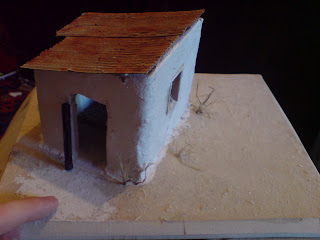I made this model as a suppliment to a business presentation at uni on wind power for poor dwellings.
First I made a mockup with cardboard and then cut each wall out of cream high density foam.
PVA glue was dabbed on the corners and then I cut up a bamboo skewer into short lengths and used it to pin the walls together.
The laboursome process of making the roof from cardboard was next, there were some small bits left on top but I think it gives it a nice ramshackle texture. The 2 halves are stuck to two foam bars.
There is a smaller corrugated piece for the SODIS unit (solar water purification).
The base is 3/4" MDF with a chamfer disc sanded in and coated in sandwust.
I dry-brushed some burnt sienna onto the roof to make it look thoroughly rusted.
The walls were coated with a paste of plaster, sawdust and water, this helps to give the walls texture and fill in the corner and base gaps.
The wispy grass is hemp fibre glued to a hole drilled in the base.I chopped up a coffee stir stick (invaluable modelling material) and used it to make a frame for the window.


















